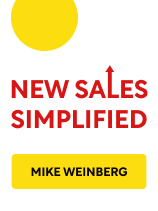

This article is an excerpt from the Shortform book guide to "New Sales Simplified" by Mike Weinberg. Shortform has the world's best summaries and analyses of books you should be reading.
Like this article? Sign up for a free trial here .
Do you want to level up your sale game? What are the most effective sales techniques?
According to Mike Weinberg, the author of New Sales Simplified, any salesperson can become a successful “sales hunter” if they learn how to wield their “sales weapons.” There are three key sales weapons: a compelling sales story, an effective cold call, and a structured face-to-face sales call.
Keep reading to learn about Weinberg’s sales weapons.
What’s in Your Sales Toolkit?
Mike Weinberg’s sales toolkit consists of eight tools and techniques, which—used proficiently—will differentiate you from your competitors.
1) Your sales story: Your sales story is a compelling, succinct, customer-focused response you give when someone asks you to tell them about your business. An effective story focuses on the problems you solve for customers and the ways your solution is different and better than anyone else’s.
2) The cold call: A cold call is a phone call in which you’re attempting to make your first contact with a prospect. It’s one of the most important and effective ways to get a meeting. While many reps fear making cold calls, you can make these calls with confidence when you know that your target resembles your best customers and you have a compelling sales story to tell.
3) The first face-to-face sales call: Getting an initial meeting with a potential client is the linchpin of new business development. Many reps go into an initial meeting with no structure or plan in mind. They end up talking too much and sounding like every other sales rep. An agenda built around your sales story will differentiate you from competitors.
4) “Discovery” questions: One of the most important parts of a sales meeting with a prospect is asking “discovery” questions to uncover frustrations, problems, and opportunities your solution could address better than anyone else’s. Asking these questions and listening to the answers is more important in the initial sales call than making a great presentation.
5) Case studies: A useful tool in a sales call is having a few case studies of how you’ve helped companies similar to your prospect’s to solve problems and seize opportunities. These examples are strong evidence of the value of your solutions. Similarly effective are third-party testimonials and recommendations, which come across as more credible than touting your own virtues.
6) Team selling: This is when the salesperson is accompanied on a call by senior executives or “subject matter experts” (such as an IT director who can discuss technical details of your solution). Their involvement underscores that you’re committed to getting the prospect’s business.
7) Presentations: Prospects often expect a presentation right off the bat because that’s what most salespeople deliver. However, to make an effective presentation, you first need to ask discovery questions so you can tailor your offering to the client’s needs and interests. A well-planned, customized presentation will make you stand out from the competition.
8) Proposals: Proposals can take various forms. You may have to respond to a formal request for a proposal (RFP). But typically, you’ll have the opportunity to create a tailored proposal for the customer. It’s one of the last tools you’ll apply in the sales process, so it’s important to make it count by sharpening your proposal writing skills.
Supplementary Weapons
Following are some additional tools and resources for sales reps, both digital and traditional.
Digital Tools
- Social Media: Social media tools, including LinkedIn, Facebook, Instagram, and Twitter, have exponentially increased the ability to research and connect with potential customers.
- Digital marketing tools: These include blogs, podcasts, videos, and online training programs providing useful information and establishing you or your company as an expert. They’re cheap to produce and easy to update. They entice prospects to want to know more about your business.
- Email: Email is often the best way to first contact a prospect—it’s the least disruptive method for the client and offers the opportunity to make an informative and creative introduction incorporating elements of your sales story.
- Voicemail: There’s often no getting around voicemail, so salespeople should take advantage of it rather than complain about it. It’s another opportunity to touch on your sales story and initiate a relationship with the prospect.
Traditional Sales Tools
- Networking: Building relationships with people who can help you do business is essential for every salesperson. Keeping an old school Rolodex, using social media, and attending events and happy hours are all useful networking methods.
- Printed marketing materials: Brochures, sales sheets highlighting product features, direct-mail pieces, and introductory letters can be a welcome alternative for the customer to digital “noise.”
- White papers and industry experts: White papers are objective reports on key industry issues. They have more credibility than a sales pitch because they quote third-party experts in the industry and academia. Another advantage is that when you share a report analyzing a problem, the customer may look to you for a solution.
- Samples and product demonstrations: These are effective when well-planned and presented but can backfire if something doesn’t work.
- Trade shows: These are useful for connecting with many customers and potential customers all at once.
- Entertainment: Traditional outside-the-office entertainment such as dinners, golf, and baseball games remains an effective way to build relationships and conduct business.

———End of Preview———
Like what you just read? Read the rest of the world's best book summary and analysis of Mike Weinberg's "New Sales Simplified" at Shortform .
Here's what you'll find in our full New Sales Simplified summary :
- A step-by-step plan for strategically selecting sales targets
- How to develop sales weapons
- How to consistently generate new sales






